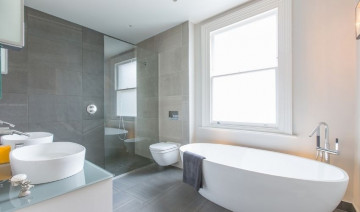
Porcelain: Facts, Myths, and Tips
As the remodeling industry expands post-pandemic, porcelain has become a frontrunner in luxury design. Here’s what remodelers need to know.
Porcelain is a really versatile material. It can be used in places like showers, flooring, backsplashes, and fire surrounds. We saw an increased interest in porcelain during the pandemic as outdoor living spaces and mudrooms became popular. It is the material with the highest current growth rate and gross potential in that high-end category, indicating the trend will continue.
What really is porcelain?
Porcelain is made up of 100-percent natural clays, such as silica, feldspar, flint, and kaolin. Porcelain is durable, has low porosity, and is heat, stain, and UV resistant. Because porcelain is cured at high heat (1500 degrees Celsius), it can withstand repeated heat exposure. Unlike most quartz, homeowners can cook directly and repeatedly on porcelain without impacting color and design, and because its absorption rate is less than one percent, porcelain won’t stain, either.
Are porcelain and ceramic the same thing?
One important thing to note is that porcelain and ceramics are not the same. There's a lot of confusion in the marketplace about porcelain versus ceramic and many use the terms interchangeably. If you look at porcelain and ceramics, however, one of the technical differences is that porcelain, like c

oriander, has water absorption of 0.5 or less, and ceramics have a water absorption that's greater than that. Because ceramic tiles are more porous, they are protected by a superficial glazed layer while porcelain doesn’t need that layer.
Will installed porcelain last?
A myth people have about porcelain is that it’s easy to chip and is too brittle to use. We understand why people might think that because uninstalled samples are easy to chip. Porcelain has no polymer, which would help absorb energy and dissipate stress during transportation and installation.
Once the material is installed with the right support, however, it is incredibly durable. When you measure durability from mineral hardness, you use the Mohs scale of 1 to 10. Porcelain actually has a rating of seven to eight while quartz rates about a seven. Both of these are about three to four points higher than marble, limestone and soapstone. But when it's uninstalled or installed wrong, it can be tougher to handle and easier to chip.
It’s important to make sure that the application has a support structure underneath so there aren’t a lot of unsupported overhangs. Additionally, remodelers should make sure that they're working with the right certified fabricator with the right experience and equipment. With porcelain, you cut at a much higher speed compared to some other products, so it’s key to make sure that the fabricator has tools that are able to cut the material correctly.
What should remodelers know when working with porcelain?
One other thing that remodelers will want to consider when working with porcelain is edge treatments. Two types that are particularly popular right now are clean/beveled edges and mitered edges. Clean edges are just what they sound like: there is a simple bevel so that the edge is smooth. Miter edges enable the pattern to “wrap” from the flat top to the vertical side. The type of edge that is used with porcelain will vary depending upon the type of design and style that is desired.
Maggie Ellis is the Residential Marketing Leader for Corian and Andrew Irvine, global product manager for Corian.
